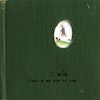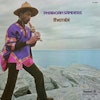Listening to múm’s Finally We Are No One is an immersive experience. Within the grooves of the record, there is a dreamlike place made of bubbly micro-drums, funereal strings, and elfin vocals that transport the listener outside of their mundane existence to another realm, somewhere fantastic but not without an undercurrent of darkness. This one-of-a-kind record was written by group members Gunnar Örn Tynes, Örvar Þóreyjarson Smárason, and twin sisters Gyða and Kristín Anna Valtýsdóttir in a remote Icelandic lighthouse where the band could exist apart from society, able to imagine a sonic world of their own creation. The mostly instrumental record has a fascinating narrative propulsion, evoking the cyclical hero’s journey structure of ancient fairy tales.
Múm (pronounced “moom”) is a difficult band to classify. At their core, they are a pop band, their work likely filed in the electronic or dance section of the record store, but their records display an intellectual heft and a spirit of experimentalism that demands further exploration by curious listeners. When this album was released in 2002, it was an emblem of the short-lived subgenre indietronica or, perhaps more specifically, folktronica—music that melded standard instrumentation with digital soundscapes, often in a more sparse, utilitarian manner than the lush and gauzy production here.
To listen to Finally is to be taken on a journey, at least partly underwater, through a grass tunnel, guided by a map of a piano, through an exotically beautiful land, and finding salvation in the subtle microtones and triumphant synth lines that reach upward, back toward the surface, where things make sense.
The album’s brief but evocative opener is titled “Sleep/Swim,” which sets up the choices for the listener: to drift off and let the album function as pretty but unremarkable sonic wallpaper, or to join the current, and to swim into the deeper, darker waters ahead. It blends seamlessly into “Green Green Grass of Tunnel,” the thesis statement where all of the elements at play are introduced. Listen closely to the drum programming, how the slices of percussion are dynamically mixed with slight volume fluctuations, playing off each other, combining to drive the ethereal synths and bewitching vocals forward. In the liner notes, album contributor Samuli Kosminen is credited as having “banged things, scraped things on the floor and built rhythms.” These unique, ever-shifting, textural percussion tracks are one of the defining elements of the record, and I can truly say that I’ve never heard anything else like them.
When I considered writing this piece, I pulled my copy of Finally We Are No One off the shelf. The record itself is a beautiful object, its cover a richly textured rendering of a storybook, worn in parts from repeated reading, passed down through generations from an unknowable past. The fifty-six minutes of music are spread across two 10-inch records. The 10-inch is the perfectly quirky record format for a strange but wonderful album like this. As I examined the album that has been keeping me company and stoking my imagination for twenty years, I noticed that the inner sleeves had begun to yellow, an elegant but unmistakable sign of aging. The gatefold binding opens more easily than it used to, the corners are worn, the cover lightly compressed, the physical toll of being played again and again when I want to traverse the mysterious and beautiful world contained inside.


